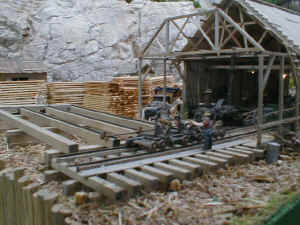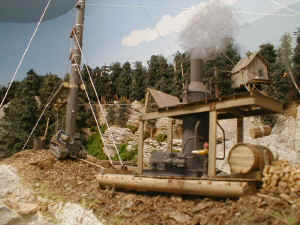 |

|
A tall man could easily walk through these forests without being brushed; first limbs 70 or 80 feet above the ground on trees 8 or 9 feet in diameter were common in the state, which overhead, the dense foliage shut off the daylight and prevented growth of most underbrush. Even as late as 1870, it was estimated that more than 60 percent of the land was still virgin forest.
The early settlers were not lumbermen, however. To them the vast forests were at best a source of lumber for their own houses and furniture; at worst, they were a nuisance that interfered with plowing and planting. When you consider that the most advanced implement a settler |
|
had for attacking a log as big in diameter as he was tall was a two-handled whipsaw, it is easy to see why timber was not considered a cash crop. Two burly sawyers could barely turn out 100 feet of cut lumber in one day with a whipsaw.
But as more people settled in western Virginia, a demand for cut and dressed lumber for houses, stores, banks, and churches sprung up. The demand
was met by primitive water-powered sawmills, which began to appear just before the American Revolution in what is now West Virginia. These early mills were little more than
|
 |
|
mechanized whipsaws, or "sash" saws, with a mechanized carriage to carry the logs and force them against the saw blade., but they represented a quantum leap in productivity; now two sawyers could turn out 500 linear feet of lumber per day.
Improvements continued to be made to these early mills, including the installation of "gang saws" or multiple blades that could saw out several boards simultaneously from one log. Ultimately, a single water mill could turn out 30,000 or more linear feet of board in one day. However it was two products of the Industrial Revolution of the early 1800's that were to turn logging into big business; the steam engine and the circular saw.
|
 |
|
Historical perspective
above is a short excerpt from "West Virginia Logging
Railroads"
Walsworth Publishing Co. Copyright 1997 TLC Publishing Inc.
Lynchburg Va.
This book is highly recommended as a source for more information on
the subject.
|
|
-  - -
|



